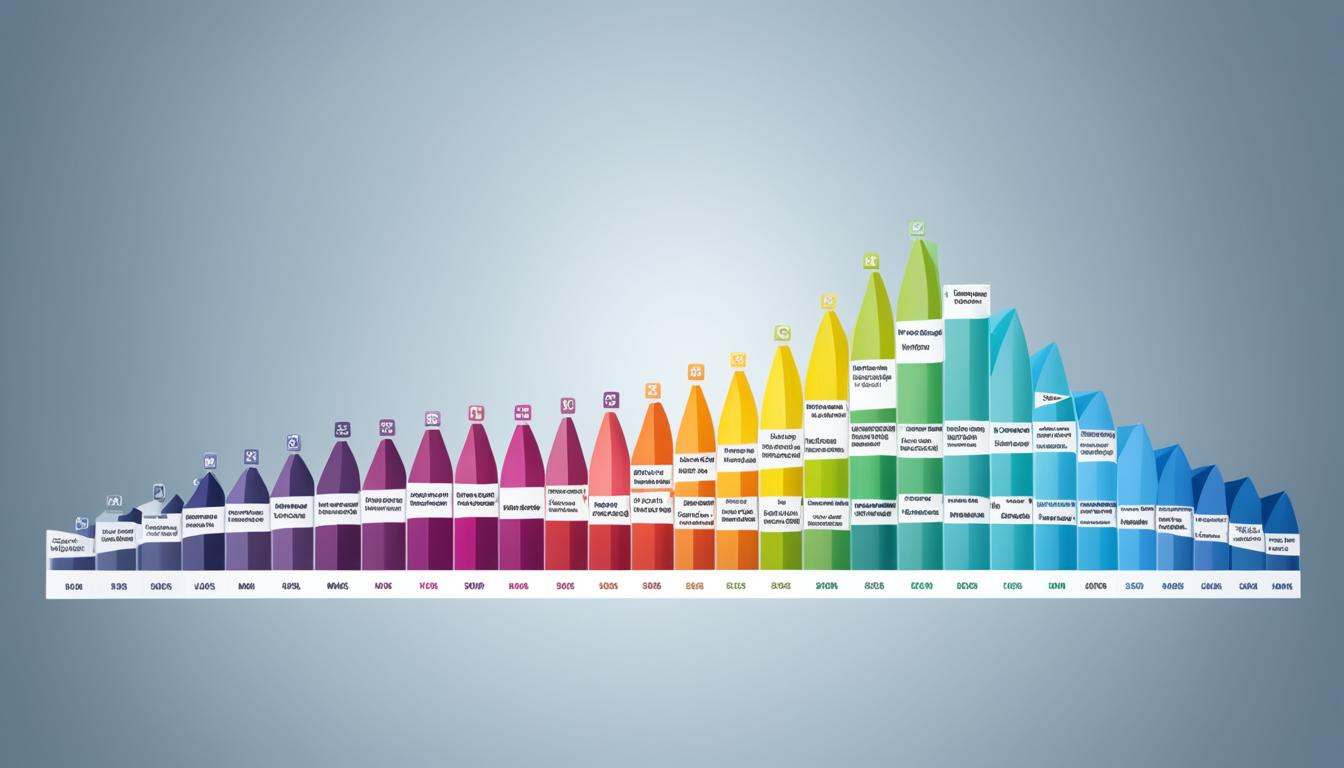An email suppression list is a key tool in email marketing. It helps keep your email list clean and compliant. This list includes contacts you shouldn’t email to protect your reputation and delivery rates.
The suppression list is needed by the CAN-SPAM Act. It makes sure you can stop emailing people who don’t want your messages. It gathers bounce, blocked, and invalid email addresses too.
Key Takeaways:
- A suppression list helps maintain email compliance and protect your sending reputation.
- It includes contacts who have unsubscribed, marked your emails as spam, or have invalid email addresses.
- Suppression lists improve email deliverability and ensure you are only sending emails to engaged recipients.
- The CAN-SPAM Act requires the use of suppression lists to honor opt-out requests.
- Regularly updating your suppression list is essential for effective email list hygiene.
Why is a Suppression List Important for Email Marketing?
A suppression list is key for keeping your sending reputation solid and boosting your email delivery. By adding unsubscribe requests, spam complaints, and inactive users to your suppression list, you make sure you’re not emailing people who don’t want your messages.
This ensures your reputation remains positive. It means you’re reaching out to people who genuinely look forward to your emails.
Using a suppression list for your email marketing can bring many benefits:
- Email Compliance: Including opt-outs and unsubscribe requests in your suppression list keeps you in line with email laws. It helps avoid sending unwanted emails.
- Improved Delivery Rates: Steering clear of sending emails to inactive or blocked addresses boosts your delivery rates. This ups the odds of your emails getting to the right people.
- Maintaining Sending Reputation: A suppression list ensures you’re emailing interested people. This cuts down spam complaints and keeps your sender reputation strong.
Key Components of a Suppression List
A typical suppression list includes:
- Unsubscribe Requests: Email addresses that have chosen not to receive your emails anymore.
- Spam Complaints: Addresses that have marked your emails as spam.
- Bounced or Blocked Emails: Email addresses that couldn’t be delivered to due to errors or blocks.
- Inactive Users: Email addresses not interacting with your emails over a certain period.
Keeping these elements updated ensures your suppression list works well. This fine-tunes your email marketing strategy.
| Benefits of Suppression Lists | Email Marketing Impact |
|---|---|
| Ensures compliance with email regulations | Supports a positive sender reputation |
| Reduces the risk of spam complaints | Improves email deliverability |
| Helps maintain a clean and engaged email list | Increases recipient engagement and conversions |
By using a suppression list, you make your email campaigns more effective. You focus on sending engaging content to those truly interested.
Use Cases of Suppression Lists in Email Marketing
Suppression lists are key in email marketing. They offer different ways to make your campaigns more effective. By using suppression lists well, you can make sure your emails match what your recipients need.
Email Frequency Control
Suppression lists help control how often you send emails. You can let people choose not to get emails for certain times or lessen emails before big events or holidays. This lets recipients control their inbox. It ensures they get emails only when they really want them.
Content-Type Tailoring
Suppression lists also let you change your email content based on what people like. By letting people unsubscribe from certain emails but keep getting others, like newsletters or deals, you don’t bother uninterested readers. This makes the experience better for everyone and may lead to more people taking action.
Product-Specific Emails
Suppression lists are great for emails about specific products, too. They let people pick the product emails they’re interested in and skip the rest. This means people only get emails they care about. This makes them happier and more likely to engage.
Using suppression lists well can make your email marketing more focused and personal. This can lead to more interest, better results, and success for your business.
Best Practices for Suppression List Management in Email Marketing
Managing your suppression list well is key for email law compliance and strong email strategies. By adopting the best practices below, you can make your suppression list more effective. This ensures that your email marketing works well and follows the rules.
1. Permission-Based Marketing
Use a permission-based marketing strategy. Only email people who agreed to receive messages. This keeps you compliant with laws and makes sure your emails go to those truly interested.
2. Centralized Suppression List
Keep a single suppression list with emails of people who opted out. Having one list simplifies managing it, ensuring emails aren’t wrongly sent in your campaigns.
3. Clear and Accessible Opt-Out Mechanism
Make it easy for people to stop receiving emails. Provide a simple way to opt out in all emails. Quickly honor these requests to show you respect their choices.
4. Regular Updates
Keep your suppression list current by regularly adding new opt-outs. This practice prevents emails from being sent to those not interested anymore.
5. Secure Storage
Protect your suppression list by storing it securely. Use strong security steps to keep the information safe. This helps to ensure that personal email details remain private.
6. Integration with Email Systems
Link your suppression list with your email or marketing systems. Automating this process helps easily avoid emailing those who opted out. It ensures everyone on the list doesn’t get unwilling communications.
7. Training and Awareness
Inform your email marketing team about the importance of suppression lists. Training helps everyone understand and respect email rules. This leads to more successful emails and a better experience for users.
How to Create an Email Suppression List
Creating an email suppression list is vital in email marketing. It ensures your emails only go to those who are interested. Here’s how you can make one:
- Gather Unsubscribed Contacts: Add people who don’t want your emails anymore to this list. It’s crucial to respect their decision to opt out.
- Address Spam Complaints: Include those who marked your emails as spam. Respecting their wishes helps maintain a positive relationship.
- Include Hard Bounced Email Addresses: Add emails that couldn’t be delivered, maybe because they were blocked or wrong. This helps in improving your email success rates.
- Identify Inactive Users: Define what makes a user inactive in your books. Then, add those who haven’t interacted with your emails for a while to the list. This way, you focus on people who really want to hear from you.
- Maintain and Update: Keep your list current by regularly removing contacts that don’t need to be there anymore. This ensures your emails are going out to the right audience.
An email suppression list makes your campaigns more effective and keeps you compliant with rules. It helps you respect recipient preferences, lowers spam complaints, improves email reach, and lets you engage with interested users.
| Type of Contacts | Description |
|---|---|
| Unsubscribed Contacts | Email addresses of individuals who have opted out of your emails |
| Spam Complaints | Email addresses marked as spam or raised spam complaints |
| Hard Bounced Email Addresses | Email addresses that have hard bounced (e.g., invalid or blocked) |
| Inactive Users | Email addresses of users who haven’t engaged with your emails within a specified period |
Implementing Suppression Lists for Effective Email Marketing
Suppression lists are key to a successful email marketing strategy. They help with email rules, sender scores, message delivery, list division, and keeping data true.
Enhancing Email Compliance and Sender Reputation
Suppression lists are important for following email laws like the CAN-SPAM Act. They include contacts who don’t want your emails or label them as spam. This respects the wishes of recipients and keeps your sender status high. It keeps you from being marked as spam and boosts email delivery rates.
Improving Email Deliverability Through Segmentation
Segmenting emails lets you send specific messages to certain groups. This raises engagement and results. With suppression lists, you avoid sending to those who shouldn’t get certain messages. This ensures emails go to those truly interested, reducing unwanted emails and raising campaign success.
Ensuring Data Integrity and Accuracy
Suppression lists keep your email list clean and current. Regularly updating them removes bad or unused addresses, ensuring emails reach active users. This keeps your data solid and makes sure your campaigns hit the right targets.
To show the effects of suppression lists, check out this comparison:
| Campaign A (Without Suppression Lists) | Campaign B (With Suppression Lists) |
|---|---|
| High bounce rate Low engagement Increased spam complaints |
Lower bounce rate Higher engagement Reduced spam complaints |
| Poor sender reputation Decreased email deliverability |
Improved sender reputation Enhanced email deliverability |
| Ineffective email segmentation Irrelevant content reaching recipients |
Efficient email segmentation Relevant content tailored to recipient preferences |
| Data inaccuracies Outdated contact information |
Data integrity Accurate and up-to-date contact information |
This comparison shows suppression lists improve many parts of email marketing. They lead to better campaign results, more engagement, and better overall success.
Knowing how vital suppression lists are can refine your email marketing. It ensures adherence to laws, helps maintain a good sender record, increases email delivery, and makes emails more personal and engaging for your audience.
The Role of Suppression Lists in Email Preference Centers
Suppression lists are vital in email preference centers. They link unsubscribe groups to specific lists. This lets people customize their email settings.
They decide what emails to get and how often. This creates a personalized email experience. Offering these choices keeps your audience happy and makes your emails more effective.
Customizing Email Preferences
Email centers let users change their email settings. They link options to suppression lists for easy management. Users pick the emails they want and their frequency.
This gives them control and personalization.
Creating Personalized Content
Suppression lists also enable personalized emails. By choosing what they like, users get relevant and engaging emails. This boosts satisfaction and engagement rates.
Enhanced Email Marketing Performance
Using suppression lists can boost your email campaigns. When users control their email settings, they’re more engaged. This leads to happier customers and better campaign results.
A user-friendly center with list options respects choices and keeps you compliant. This approach makes for better email experiences and stronger customer relationships.
Benefits of Email Suppression Lists in Email Marketing
Email suppression lists play a big role in email marketing. They help your campaigns in many ways. By using them in your strategy, you follow email rules, respect people’s choices, and make your campaigns work better. Let’s look at the main benefits of email suppression lists:
1. Ensuring Email Compliance
It’s important to keep trust and credibility with your audience. Email suppression lists help you respect opt-out wishes. This keeps you in line with laws like the CAN-SPAM Act. It also lowers spam complaints and the risk of legal issues.
2. Preventing Unwanted Emails
Stopping unwanted emails is key to a good reputation and reaching the right people. Suppression lists stop emails to those who have opted out. This action keeps your reputation safe and avoids your emails being marked as spam.
3. Effective Email Segmentation
Segmenting your emails makes them more personal. Suppression lists help you target your messages better. You can sort lists by what people like, such as how often they want emails. This way, your messages hit the mark, boosting interactions and results.
4. Maintaining Data Integrity
Good data is essential for email marketing. Suppression lists keep your email list clean and current. Keeping your list updated with opt-outs keeps your emails going to the right places. This improves your email reach and keeps your audience interested.
| Benefits of Email Suppression Lists | Description |
|---|---|
| Email Compliance | Ensure compliance with email regulations by honoring opt-out requests and preventing unwanted emails. |
| Preventing Unwanted Emails | Reduce the likelihood of spam complaints and maintain a positive sender reputation by excluding unsubscribed recipients. |
| Effective Email Segmentation | Tailor your email messages to specific recipient groups based on preferences, leading to higher engagement and conversions. |
| Maintaining Data Integrity | Keep your email list accurate and up-to-date by regularly updating suppression lists, improving email deliverability. |
In conclusion, email suppression lists are very useful in email marketing. They help follow rules, stop unwanted emails, make your messages more personal, and keep your data right. Using them in your strategy makes your campaigns work better. This leads to better results and more interaction with your audience.
How to Exclude Suppression Lists in Email Campaigns
To make sure your email campaigns only reach those who should get them, use email marketing tools like weMail. These services let you not send emails to certain subscribers or even whole lists you don’t want to reach.
With tools like weMail, you can easily remove people or lists you don’t want to email. This helps your campaigns work better by improving targeting, upping engagement levels, and keeping a good rep as a sender.
The Benefits of Excluding Suppression Lists
Leaving out suppression lists from your email campaigns has big pluses:
- Higher deliverability rates: Avoid sending emails to those who opted out or unsubscribed. Your emails will then reach people who really want them, making your deliverability rates go up.
- Better engagement metrics: By not emailing those who aren’t interested anymore, you can concentrate on people who actually care. This means more engagement and more conversions.
- Enhanced sender reputation: Staying away from those who marked your emails as spam helps protect your sender reputation. A good reputation is crucial for email marketing success in the long run.
For better email campaign results, excluding suppression lists is a smart move.
| Steps to Exclude Suppression Lists in weMail: | |
|---|---|
| 1. Login to your weMail account | |
| 2. Go to the Email Campaigns section | |
| 3. Select the desired campaign | |
| 4. Look for the Suppression Lists or Exclusion Lists option | |
| 5. Choose whether to exclude specific subscribers or entire suppression lists | |
| 6. Save your changes and proceed with sending the campaign |
Follow these steps in weMail to avoid mailing those on suppression lists. This fine-tunes your email campaigns, making them more effective.
Best Practices for Email Suppression List Management
To manage your email suppression lists well, follow certain best practices. With these practices, you can stick to email rules, keep a good sender reputation, better email delivery, and improve email marketing. Let’s dive into these practices.
1. Honor Unsubscribe Requests
It’s key to respect unsubscribe requests for email compliance. Remove emails quickly from your list once they opt out. This shows you value recipient choices and builds trust.
2. Regularly Update Suppression Lists
Update your suppression lists often. Take out emails that have unsubscribed or opted out to keep your lists accurate and relevant. This keeps your suppression list effective.
3. Implement a Double Opt-In Process
A double opt-in confirms subscriptions and limits incorrect emails on your list. Subscribers click a link in their email to confirm. This ensures you add only interested recipients.
4. Segment Suppression Lists
Divide your suppression lists by suppression reason for better management. Categorize them, like unsubscribes or spam complaints, to quickly see delivery issues. This lets you fix problems fast.
5. Automate Suppression List Management
Using email software with automation makes suppression list management easier. It updates lists and removes inactive emails automatically. This saves you time and reduces errors.
6. Implement Inactivity Suppression
Remove inactive subscribers to better your email delivery. This focuses your efforts on engaged users, boosting your campaign’s performance.
7. Audit and Monitor Suppression Lists
Regular audits help keep your suppression lists correct and up-to-date. Make sure they match your marketing needs and follow rules. This catches and fixes any issues promptly.
Following these practices for managing email suppression lists helps you follow rules, protect your sender reputation, and improve email marketing performance.
Types of Email Suppression Lists in Email Marketing
Email marketing gets better with different suppression lists. These lists ensure you are compliant, boost deliverability, and connect with interested people. Here’s a look at the various suppression lists:
1. Hard Bounces
Hard bounces mean emails that are no good or blocked. Having these in your suppression list stops wasted efforts. It makes sure your emails go to people who can actually get them.
2. Spam Compliance
Spam compliance lists have emails marked as spam or with complaints. Avoiding these emails keeps your sender status positive. It’s vital to not be seen as a spammer.
3. Unsubscribes
Unsubscribe lists hold emails from people who don’t want your messages. Respecting their decision is crucial. It keeps you in line with rules and shows you value their choice.
4. Preference-based Suppression
Preference-based lists let people set their email likes. They can stop getting certain emails but still receive others. This makes their email experience more personal and fitting.
5. Legal and Regulatory Suppression
Legal suppression lists keep you right with laws in your target areas. They stop emails to those needing special opt-out rights. Following the law is essential.
6. Customized Suppression
Customized lists are made just for your business and goals. They let you exclude certain people from specific emails. This aligns your emails with what your audience prefers.
Using these suppression lists boosts your email marketing. You’ll be compliant, improve deliverability, and give a customized touch to your audience’s inbox.
Conclusion
Email suppression lists are key for successful email marketing. They help you follow the rules, keep a good sender reputation, and make sure emails are personalized and valid. This way, your emails get to the right people and make a real difference.
To manage suppression lists well, quickly honor unsubscribe requests and keep your lists up-to-date. Also, organizing them by specific criteria makes your email campaigns more effective. Using email marketing tools with suppression list features helps automate this process, increasing accuracy and improving how many of your emails are successfully delivered.
Suppression lists boost email engagement by letting you customize content for your audience. Sending tailored emails to active subscribers enhances their experience. It also strengthens their connection to your brand. Plus, avoiding people who don’t want certain emails improves your email marketing quality and relevance.
In the end, using email suppression lists the right way leads to better email delivery, stronger compliance, a good reputation, and closer engagement with your audience. By making these lists a part of your email strategy and following best practices, you can greatly improve your campaign’s effectiveness.







